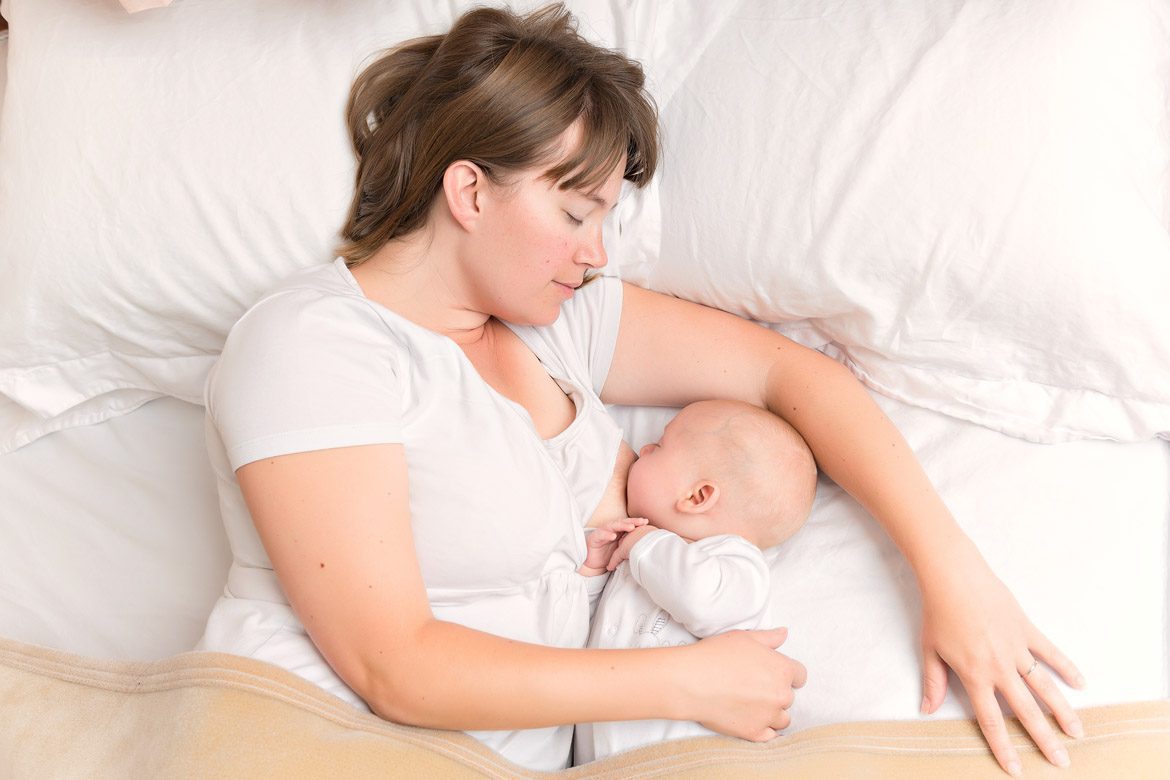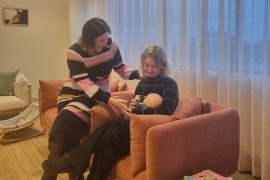By Megan McCue
Breastsleeping: NORMAL, HEALTHY, SAFE, COMFORTING.
Breastsleeping is a term coined by infant sleep researcher James McKenna, of the University of Notre Dame. It defines the act of a breastfeeding mother sleeping in close proximity to her baby, with feeding occurring throughout the night. It is a practice that has become clouded with fear, guilt, and misinformation in our current society. This article aims to provide parents with evidence-based, practical information, so that they can feel empowered and confident about their sleeping situation, whatever it may be.
NORMAL
“For primates, the mother is the environment.” – Sarah Blaffer Hrdy
Breastsleeping is the human species’ biological norm. Mammals evolved to sleep with their infant offspring, and primates in particular are known to breastfeed often throughout the day and night in the first few years of life. Human breastmilk is relatively low in protein and fat, making it easily digestible and increasing the need for frequent feeding. This round-the-clock feeding maintains a mother’s milk supply, making it more likely that she will remain close to her infant and breastfeed for a longer total duration. Because of the adaptability of frequent waking and feeding throughout the night, breastsleeping and shared sleep is how human infants evolved to interact during the night. It wasn’t until the 19th century that pediatricians (mostly white, upper middle class men) began promoting the idea that babies did not need food or touch during the night; a “good baby” was one who “slept through the night” alone in a separate room from their parents. These claims not only lacked substantiating evidence, they also undermined successful breastfeeding, and shockingly, continue to be perpetuated by many pediatricians and media sources today.
The majority of the world practices some form of co-sleeping (including bed-sharing and room-sharing), while reported rates of co-sleeping in the US tend to be very low (around 14% in one 2010 study). However, there is good reason to believe that these reported rates are much lower than actual co-sleeping rates, as many parents do not admit to bringing their baby into bed with them, due to socio-cultural stigma.
HEALTHY
“Touch is critical for children’s growth, development and health…yet, the American society is dangerously touch-deprived.” – Tiffany Field
Researchers are just beginning to uncover the plethora of physical and emotional benefits of sleeping in close proximity to our babies and providing them with skin-to-skin contact. They have identified a number of physiological systems that are regulated in babies when their mums sleep within arm’s reach, including:
- arousal patterns
- breathing
- body temperature
- metabolic rate
- hormone levels
- enzyme/antibody production
- immune system
We know that when babies sleep in close proximity to their breastfeeding mothers, they are immersed in a rich sensory experience. They go through lighter stages of sleep, arouse more often, and breastfeed more frequently, decreasing their risk for SIDS and increasing their overall immunological health. (McKenna et al, 1993)
Additionally, babies who co-sleep are less likely to suffer from serious illnesses in first 6 months of life, and have been shown to have lower levels of cortisol than babies who don’t co-sleep. (Sutherland)
SAFE
“Research on infant sleep risks shows that the big risks of shared sleep are a mix of SIDS risks that affect vulnerable babies and breathing hazards that affect all babies: smoking, alcohol or drugs, risky surfaces, baby on his front (unless he’s on an adult chest), and formula feeding.” – La Leche League International
The internet is chock full of misinformation about safe sleep guidelines, and sadly, The American Academy of Pediatrics (AAP) has done much to denounce bed-sharing as an across-the-board unsafe practice. In reality, research has shown that, when practiced responsibly and with the right precautions, intentional bed-sharing can be protective against SIDS and a safe and beneficial option for breastfeeding mums.
The following safety guidelines should be adhered to when bed-sharing and breastsleeping.
Environmental:
- Flat, firm mattress
- No fluffy duvet/pillows that could obstruct baby’s face
- No gaps between mattress/wall
- No hanging cords nearby
- Never sleep on a sofa, water bed, recliner, or other non-firm mattress
- No pets should be in the bed
See next page for more…











